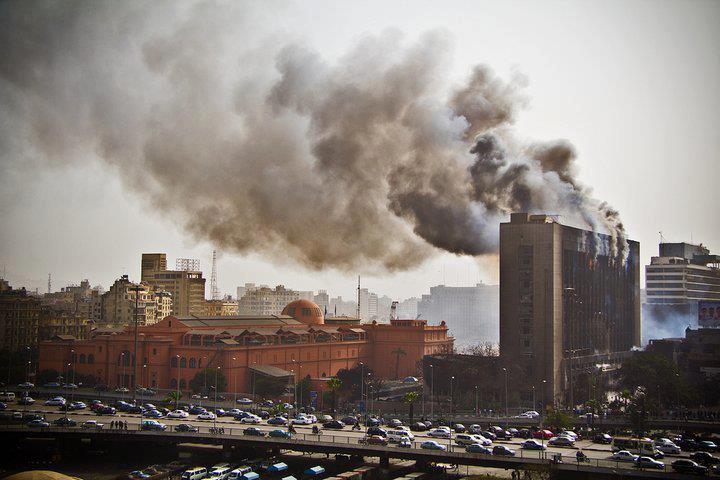On Sunday, the Egyptian government ordered the demolition of Mubarak’s National Democratic Party’s (NDP) headquarters, which for many was the stronghold of the regime’s corruption and monopolistic dominance. During the pivotal days of the 25th of January revolution, the building was looted, destroyed, and set afire by protesters. The demolition of the building follows the pattern of the remodeling and redecoration of Tahrir Square only six months ago. An underground garage was built, buildings surrounding the square are being remodeled and repainted, and upscale stores and coffee shops are opening, all to increase tourist attention to the area while enhancing the quality of citizen services.
I am not going to object to the NDP building being demolished, as it is in a very valuable area of Cairo that the government needs to make use of. I am, however, going to talk about the significance of the building’s destruction and what seeing it being devoured by the flames meant to some.
In a sense you could say that the fall of the NDP building meant the fall of Mubarak’s regime – at the time. It followed the immediate retreat of El Adli’s police forces to God knows where, and shortly before the army swept the streets to protect pivotal areas around Egypt. Images of the building were seen around the world and it was a significant hallmark during the revolution itself. The building represented the most powerful political hierarchy in the country, only to be made obsolete as smoke emitted from its broken windows, smoke that could still be seen in the early morning that followed. The demolition instilled a feeling of invincibility in many of the protesters- that an entity as powerful as the NDP could have its headquarters burned down by the might of the people it ruled over. For me, it instigated the point where the protestors realized they were more powerful than the state and that it was time they took control- and for the next 13 days they certainly did.
Now it has been days since the building was demolished. For those who frequent the area, they will no longer be able to see the commanding structure that served as a nostalgic – or daunting depending on your stance – reminder of the uprising in 2011.
Regardless of what decorations, renovations, demolitions, or remodeling occurs, it’s the memory and purpose of the building that we should all remember. We should not bemoan that it will no longer be there, or use it as an indicator to highlight a failure of the revolution because a revolution that defines itself by the remains of physical buildings is not a revolution at all. It is quite the opposite- a sign of a revolution that has been depleted, exploited and devoid of any sort of purpose other than fading memories of an uprising that once was.
Some say the building remaining in its destroyed state will serve as a reminder of what happens when the government betrays its people. While that is true, the government showed no concern of these views and went ahead and demolished the building without asking how anyone felt. Whether you agree or not, the building had lost its meaning to many for quite some time now. Regardless of it remaining there or being removed, nothing would change that.
The building will no longer be there, and there is nothing we can do about that. What we can do now is correct past mistakes and make sure its meaning is beyond physical and material manifestations. That no matter who rules, or which government orders it to be taken down, its magnitude will always be prevalent. Governments will come and go, and most of them will purposefully attempt to eradicate those 18 days from memory. It is our job to resist that.
We can do this through awareness, through each and every one of us reminding people of what happened in 2011, of the people that gave their lives. We should remind everyone of the magnanimousness of what it meant to destroy the building that represented decades of corruption which left a country impoverished and decadent.
Ideas are beyond buildings, they are beyond squares. Tahrir Square was simply a venue; another location could have been the home of the revolution. It was just convenient due to its size. The NDP headquarter was simply a building. However in both cases, it was the people, the protesters that gave them significance. Tahrir Square represented liberation while the NDP building represented oppression.
We must remember the events that surrounded these landmarks, the people that were there and the people that were killed. Those are the memories we should uphold. The building is no longer there, but the idea behind it will transcend beyond a thousand bulldozers. We should instead remember the individuals themselves that are being wiped out from memory through imprisonment, or by a media that day by day continues to treat the revolution like an event that came and passed. We should fight for the idea, not for buildings.
Edited by Kari Mageed.






Comment (1)
For the record, the remodeling of Tahrir has been planned since 2009. That garage wasn’t built in a year. If you look at pictures from the 2011 revolution, you can see the garage being built. It is not a sign of propaganda to remodel the square.